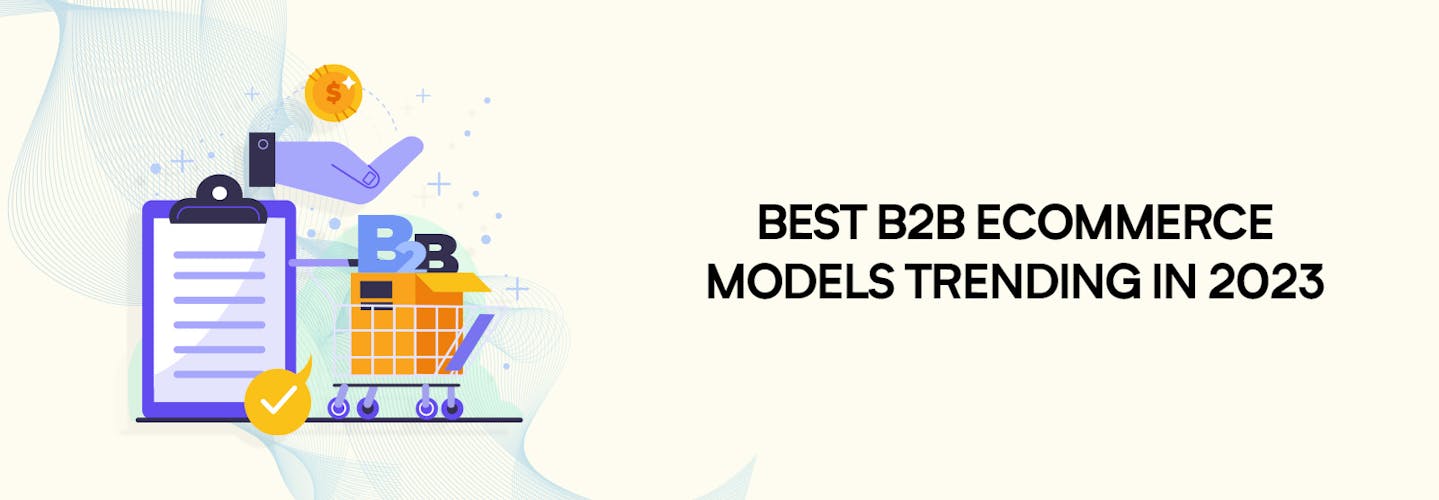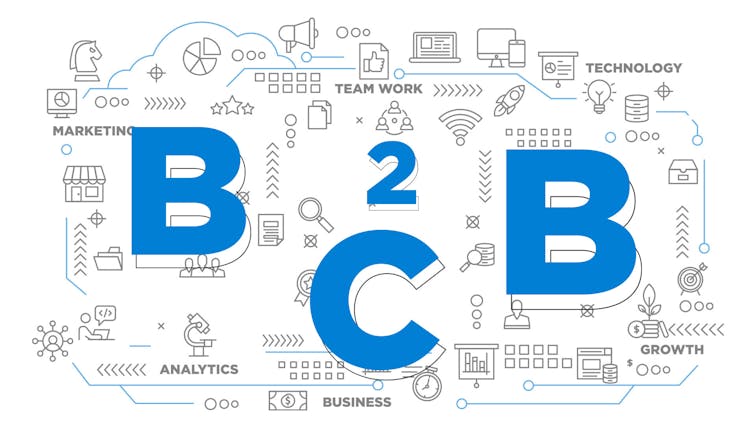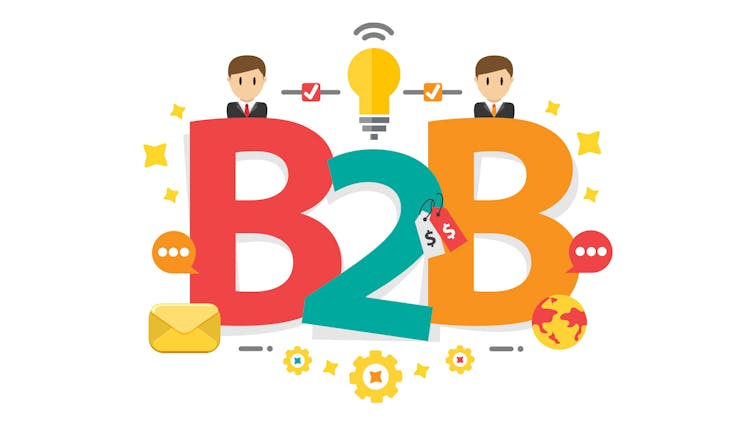
Top B2B Ecommerce Models and Trends That Will Be Popular in 2025
Each year, something new keeps the B2B model in ecommerce highly relevant. Unlike B2C ecommerce marketing, which is consumer-oriented, B2B marketing puts its entire focus on marketing products to other organizations.
Simply put, B2B marketing is for businesses that sell to other businesses, and its many forms are used to ease B2B functions like subscriptions, tools, SaaS (software-as-a-service), and so much more.
The main goal of most successful B2B sales approaches is to retain more customers and ensure they stay interested in purchasing more. B2B marketing tactics must have a high success rate as they require thoughtful planning, proper execution, and management.
In this article, we will dive deep into the concept of B2B, its different types, and the best B2B ecommerce models trending in 2023.
A Brief Summary of B2B and B2B2C:

As mentioned earlier, B2B is a model facilitated between businesses where one is a manufacturer, and the other is a wholesaler. There are situations where one is a wholesaler, and the other is a retailer.
The B2B model focuses on solution-based sales and builds on solid customer relationship management to stimulate the overall growth of a business. The transactions generally happen in the chain of supply where one company purchases raw materials from the other to use in the manufacturing process.
The B2B2C ecommerce platform, on the other hand, is where ecommerce businesses get in touch with new customers and markets by building partnerships with consumer-oriented product businesses.
As a B2B2C ecommerce example, suppose Business P pays Business Q for leads, sales, or users generated by their (Business Q’s) website. Later, Business P uses Business Q’s channels in order to locate new prospects.
Business Q offers new and useful services to its customers and facilitates a wide customer base along with earned revenue for the sold products.
Top B2B Models in ecommerce:
B2B is a vast concept, and to understand each aspect of the same, the only fair way is to categorize it under different kinds of B2B ecommerce business models.

Category 1: Based on the Marketplace’s Architecture
A marketplace consists of three stakeholders—sellers, buyers, and admin—and the marketplace’s architecture can differ based on which of the mentioned three owns and starts the business.
Here are the three possibilities that emerge as the change of control occurs among the parties mentioned above:
1. Intermediary-Oriented Marketplace Model
This model involves online marketplaces that allow communication and transactions of sellers and buyers with one another. Here, the owners of the marketplace maintain a log of the sellers and buyers, and their main goal is to earn a profit from the associations.
2. Buyer-Oriented Model
This model revolves around the buyer’s demands and is reasonable for big corporations with great purchasing power along with high-volume purchasers or entrepreneurs considering launching a B2B online marketplace that emphasizes buyers’ needs.
In both cases, buyers initiate the transactions. Buying businesses establish a portal online to accept quotations coming from different sellers. After an in-depth analysis, the quotes start flowing, which allows the buyer to decide on the seller with whom they want to make transactions.
This way, the buyer-oriented model of B2B allows buyers to cut administrative costs and get products at their best price from suppliers.
3. Supplier-Oriented Model
In this model, suppliers join hands and set up a marketplace online. This marketplace establishes a well-planned channel for them to sell their products to a large number of business organizations. The suppliers have the freedom to set prices based on the needs of the buyers.
In such online marketplaces, businesses can search for suppliers based on the products they have to offer, and an admin assigned by the sellers manages the marketplace.
This business model needs to have goodwill in the market and loyalty to become successful.
Category 2: Based on the Service Industry
This category demonstrates how business models have been shaped based on the industry the marketplace has been built to be in service of.
1. Horizontal Business Model
B2B marketplaces based on this model cater to a huge variety of products across industries.
2. Vertical Business Model
This kind of marketplace keeps its focus on one specific industry. By doing this, it narrows the target audience base because it makes it easier for them to understand which marketing strategy will work best.
As a result, the target audiences are offered tailored value propositions from the sellers.
Category 3: Based on Commodities Offered at the Marketplace
The B2B space depends on the B2C industry and makes its moves depending on B2C’s situation in the market.
Manufacturers, as well as distributors, have understood the economics behind venturing downstream of the value chain over time, and this has brought a big change in their ideas and perspectives.
Now, B2B marketplaces and other digital sales channels use this perspective to introduce dynamic business models. The following are the options that they go for:
1. Offering Products and Service Exclusively
B2B marketplaces now put their focus on connecting demands with product supply.
2. Offering Other Services with Products
Depending on the marketplace’s operative niche, offering services alongside products makes it easy for the seller to offer added value to buyers.
There are a large number of industries where this move accounts for a great share of the revenue. Hence, considering other useful services along with products can broaden a marketplace’s horizons.
Networking Marketplaces:
There are quite a few marketplaces whose main goal is to connect sellers and buyers by working as intermediaries.
The networking model has a bright future ahead of it because it provides small distributors, manufacturers, and other B2B sellers—who generally do not possess enough marketing abilities—to reach out to a wide audience base with a platform to express themselves.
Networking marketplaces are already in the limelight, and in the near future, we’re very likely to see their immense potential.
Top 10 B2B ecommerce Trends That Will Be Popular in 2025:
Even though there’s no denying that B2B was quite popular among companies in the last couple of years, the COVID-19 pandemic accelerated its growth in the year 2020.
Due to the pandemic, a large number of physical stores had to shut down for a long time, and this led to huge losses for the sellers. That’s no longer a problem for most sellers because they have successfully adapted to the concept of B2B.
However, the trends keep changing every year, and businesses must stay abreast with them if they want to be relevant and secure a good position. That said, let us take a look at some of theB2B ecommercetrends for 2025.
1. Omnichannel Experience
Attracting consumers and keeping them interested is now more challenging than ever due to the increasing competition online and because consumers now have access to unlimited information.
Focusing on customer experience is vital for B2B ecommerce companies to ace this part. Cultivating an omnichannel business presence is a necessary step to tackle this situation.
It will ensure uniformity across all the touchpoints, allowing prospects to navigate through the social channels of a business freely.
2. Social Commerce
A large number of people now rely on social media to make their purchases online, and that’s what makes social media platforms extremely important in the era of digital marketing.
Using social media platforms is a must to reach out to the right audience, make them check out a certain product, and turn them into customers.
B2B businesses can now establish their ecommerce stores on social media platforms like Instagram, Facebook, and even Pinterest.
3. Digital Supply Chain Management
The global supply chains were deeply affected after the outbreak of the COVID-19 pandemic, and a lot of B2B companies’ loopholes were exposed, especially those whose supply chains were dependent on China.
As a result, a huge percentage of B2B companies decided to minimize their dependency on countries like China and focused on increasing the dimensions of the existing center.
To shield against abnormalities in the global supply chain, B2B businesses must concentrate on integrating the capabilities of the foundational supply chain with the trending strategies.
4. Personalized Customer Experience
Segmentation of customers using demographic data is no longer very helpful—it’s time to dig into a customer’s behavioral attributes to fulfill the goal of taking personalization to the next level.
Businesses need to keep track of why, where, and when consumers shop to present them with the right product or service.
Forming customer-centric moments is a good way to increase brand loyalty, and RoX (return on experience) is a very effective way to keep track of this aspect.
5. Mobile Wallets

It’s completely normal for a B2B buyer to expect a seamless digital payment experience, and B2B brands that are still lagging in this are very likely to lose to their competitors.
It’s high time to prioritize mobile wallets as a checkout option because there will be situations when a potential buyer will abandon their shopping cart just because a certain payment option is unavailable.
6. Sustainability
Sustainability now swoops in the middle of everything a B2B business does, and if we give this a deep thought, sustainability is actually very useful for a business.
It’s time for more and more companies to understand the importance and benefits of sustainability because it is not just good for the environment but also for businesses.
Research has shown that businesses that claim to be eco-friendly attract 4.3 times more customers than those that don’t. There’s more—the conversion rate for eco-friendly businesses increases by up to 20%.
To begin a journey towards sustainability, eco-friendly product packaging is the way to go. Of course, there are plenty of other ways a company can become sustainable. The goal should be to find the one that ticks all the boxes and does not cause extra hassle for the company.
Sustainable packaging indeed costs more than the regular kind, but let’s not forget the impression it creates on the consumers—if implemented the right way, the increase in revenue will be remarkable, and packaging costs will no longer affect the company’s profit.
7. Automated B2B Transactions
Automation is extremely important for B2B to ensure the customer experience is smoother than ever. Not to mention, this step is bound to enrich the reputation of online marketplaces.
ecommerce trends will include more automation in the upcoming years, which will consist of automated accounts payable and receivable, reordering and order fulfillment, and so on.
Here are some key reasons why businesses must embrace B2B automation tools for payments:
- The incorporation of payment automation tools will ensure frictionless payment.
- There will be enhanced control over the processing of each payment.
- A whole lot of time, as well as business resources, will be saved through streamlined data entry.
8. Augmented Reality for Visualization of Purchases
As previously discussed, the pandemic left no choice for physical stores and companies. To survive and thrive in the competitive field of business, it was necessary to turn to ecommerce.
To take the online shopping experience of consumers to the next level, AR (Augmented Reality) marketing has been very helpful. Studies show that the use of augmented reality has doubled conversion rates for online retailers and even increased the cart size by 60%.
This massive growth has inspired many enterprises to launch AR integrations. The addition of AR will not only smoothen the online shopping experience of consumers, but business owners will also highly benefit from this because a whole lot of unwanted hazards will be eliminated.
9. Demand for Quick B2B Order Fulfillment
With the advancement of technology, expectations from businesses have changed. Now, as we are living in the post-Amazon world, we want everything done in an instant.
Software is being built to manage B2B orders across various sales platforms and even centralize all the information while end-consumers order products online. This brilliant incorporation has reduced complexity in the supply chain and smoothened the job for everyone involved.
10. Brand Strategy in Metaverse

In simple terms, Metaverse is the concept of a virtual world that is highly immersive where people come together to socialize just like they do in the physical world. It is considered three-dimensional and has multi-sensory features, including a touch sensor.
Metaverse is the future of internet advancement, and businesses are all set to adapt to this feature in the upcoming years. Creating your business’s space in the Metaverse is one of the biggest moves you can make in the current business scenario.
Many B2B retailers have already seen great improvement after this move, which has been extremely helpful for customers because now, they can try products before making purchase decisions.
Conclusion:
While B2B and B2C ecommerce strategies in 2020 and 2021 were all about getting online to reach the right audience and increase revenue, the focus for 2022 is optimization of buyers’ online shopping experience to ensure that none of their expectations are left unmatched.
To reach this end goal, it is crucial for B2B businesses to keep track of all the emerging trends and use them to the fullest. By following the aforesaid models and tips and leaving legacy systems behind, B2B businesses can achieve all-round success.
Use aasaan, a no-code ecommerce platform, to create your online business conveniently and market your products among your target customers. Experiment with the top trends and utilize them to grow your business, the aasaan way.








